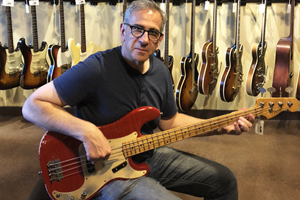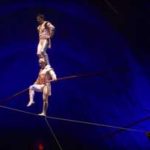Are his ideal instruments “good enough,” or do we need more?
By Jon Liebman
Week of February 18, 2019
We just published a very upbeat and fun interview this week with the inimitable Dann Glenn, who’s done everything from composing symphonies and authoring books, to scoring films and playing bass with some of the biggest names in the music world.
In addition to hearing Dann talk about his never boring life and career, including his recent return to bass playing after a debilitating accident, the always cheerful Dann just couldn’t say enough about his prized Dingwall basses. Employing Sheldon Dingwall’s patented “fanned fret” design, Dingwalls are highly unique, to say the least. What’s even more intriguing about Dann’s Dingwall basses is that they’re fretless. Yes, he plays a 6-string fretless, fanned fretted bass. Go, Dann!
It’s quite fascinating to think about the metamorphosis of the electric bass, from Leo Fender’s earliest prototypes, to some of the wildly creative instruments being made today. On the one hand, you’d be hard pressed to find any argument negating the fact that Leo Fender absolutely nailed it with his exquisite electric bass design.
But no matter how excellent a product is, there’s always someone with a new idea, a different approach, a never-before-thought-of concept. After Fender made his indelible mark on the music industry some 65+ years ago, other prominent luthiers and designers began to appear, like Mike Tobias, Vinny Fodera, Roger Sadowsky, and, more recently, Pete Skjold, Gerald Marleaux… the list goes on. We’ve also seen profound innovators, like Ned Steinberger and Emmett Chapman, relentlessly pushing the boundaries of an instrument’s possibilities, constantly bucking tradition.
How many ways can an instrument – especially an ideal instrument – be reconfigured, reconceived, and remanufactured? How many “new takes” can there be on design, sound, electronics and playability?
Having just returned from another NAMM show, I can attest to the fact that creativity and innovation aren’t going away any time soon. There are always new surprises to behold and, undoubtedly, something completely unexpected lurking right around the corner (who would have ever thought of making a fretless fanned-fretted bass?!).
Putting inspiration ingenuity, and originality to work can be a beautiful thing. Even when there’s nothing wrong with the product in the first place.
Have a thought on the subject? Leave a comment below and let me know what you think. In the meantime, check out my interview with Dann here.






No matter how many innovations luthiers come up with, Leo Fender absolutely got it right with his electric bass design. Just like Larry Graham is the father of slap bass, “Thumping and Plucking” and now you have players like Victor Wooten, the Fender bass is the father of electric bass. Like everything else, of course technology, will always evolve, making for some futuristic and new designs, sounds and luthiers.
Leo Fender got it right, very right. But here’s another advantage Fender has as a brand/design: have you ever tried to get replacements for proprietary hardware, be it an old BB series Yamaha, a new Ibanez or some innovative boutique design? Maybe, new builders and hardware companies should regroup as a whole and establish a certain standard at least in terms of hardware and electronics, so if you buy a non fender standard bass, you get the chance to upgrade or replace easily any component.
Depends on the player ,and his current gigs . I sold off all my “Modern design basses” and went to a J and a P bass and that’s it . Haven’t been limited by that move yet ,so yeah…. At this point I would rather buy traditional basses and upgrade parts to do what a new gig or project might require . ie: I have a J that’s tuned down to B . Have another with EMG J’s for Metal ,another with a drop in sadowsky pre amp, etc etc .That said, A Traditional, not upgraded, J & P do handle my current gigs just fine .
It’s incredible how most of us bass players still love our boutique basses but always go back to the Precision,somehow that FATNESS of the Precision is the foundation of all modern music we hear from the 50’s to present day high end recordings!
Leo never stopped developing instruments the whole of his working life. He realised the first 5 and 6 string basses and the first popular bass with active electronics. We need to stop pretending the his success ended in the 1960’s. He continued to market newer, more innovative designs with Musicman and then G&L right up to his final days.